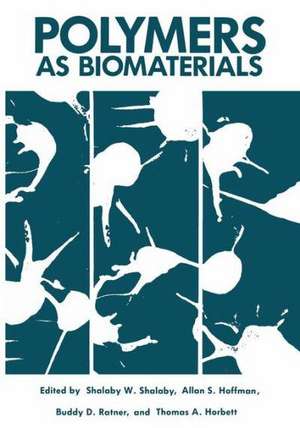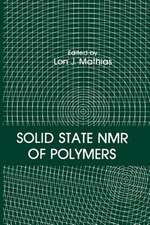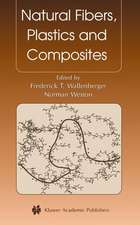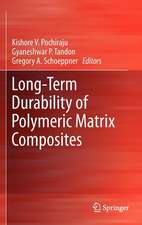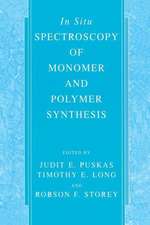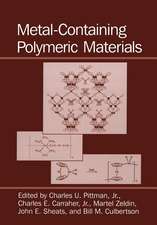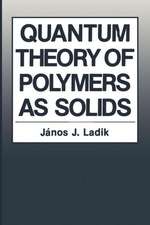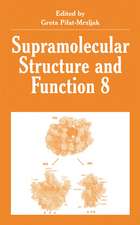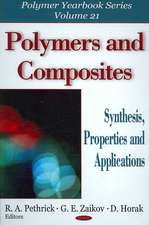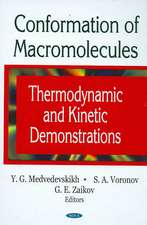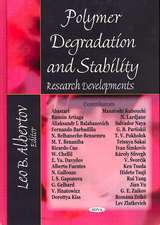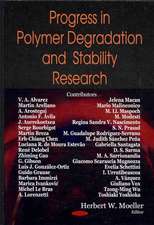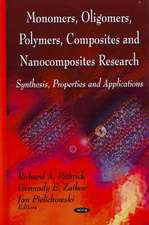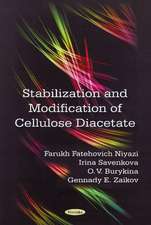Polymers as Biomaterials
Autor W. Shalabyen Limba Engleză Paperback – oct 2011
Preț: 400.10 lei
Nou
Puncte Express: 600
Preț estimativ în valută:
76.56€ • 83.42$ • 64.51£
76.56€ • 83.42$ • 64.51£
Carte tipărită la comandă
Livrare economică 23 aprilie-07 mai
Preluare comenzi: 021 569.72.76
Specificații
ISBN-13: 9781461294801
ISBN-10: 1461294800
Pagini: 404
Ilustrații: X, 390 p.
Dimensiuni: 178 x 254 x 21 mm
Greutate: 0.7 kg
Ediția:1984
Editura: Springer Us
Colecția Springer
Locul publicării:New York, NY, United States
ISBN-10: 1461294800
Pagini: 404
Ilustrații: X, 390 p.
Dimensiuni: 178 x 254 x 21 mm
Greutate: 0.7 kg
Ediția:1984
Editura: Springer Us
Colecția Springer
Locul publicării:New York, NY, United States
Public țintă
ResearchCuprins
Section A Materials & Properties.- Poly(?-Malic Acid) as a Source of Polyvalent Drug Carriers: Possible Effects of Hydrophobic Substituents in Aqueous Media.- Polypentapeptide of Elastin as an Elastomeric Biomaterial.- Development of Non-Thrombogenic Materials.- The Use of Polyacrylates in the Microencapsulation of Mammalian Cells.- Melt Spinning of Poly-L-Lactide and Hydrolysis of the Fiber In Vitro.- Some Morphological Investigations on an Absorbable Copolymer Biomaterial Based on Glycolic and Lactic Acid.- Structural Identification of CIS-Platinum II Polyhydrazines.- Flourescence in Polymers: 2-Diphenylacetyl-l, 3-Indanedione-l-Imine Derivatives in Polymer Matrices.- Section B Surface Characteristics.- An XPS and SEM Study of Polyurethane Surfaces: Experimental Considerations.- Polymer Surfaces Possessing Minimal Interaction with Blood Components.- Thermodynamic Assessment of Platelet Adhesion to Polyacrylamide Gels.- Section C Interaction with the Biologic Environment.- Reproducible Response of Certain Polymers to Changes in the Surrounding Environment.- Mechanism of the Biodegradation of Polycaprolactone.- Swelling Behavior of Glucose Sensitive Membranes.- Section D Biological Interactions with Polymeric Surfaces.- Selected Aspects of Cell and Molecular Biology of In Vivo Biocompatibility.- Molecular Design of Materials Having an Ability to Differentiate Lymphocyte Subpopulations.- Attachment of Staphylococci to Various Synthetic Polymers.- Blood Compatibility of Polyethylene and Oxidized Polyethylene in a Canine A-V Series Shunt: Relationship to Surface Properties.- Section E Drug Delivery Systems.- Polymer Based Drug Delivery: Magnetically Modulated and Bioerodible Systems.- Oral Sustained Release Drug Delivery System Using Polymer Film Composites.- ChemicalCharacterization of an Immobilized Heparin: Heparin — PVA.- Tumorcidal Activation and Kinetics of Ectoenzyme Production Elicited by Synthetic Polyanions.- Section F Hydrogels.- A Responsive Hydrogel as a Means of Preventing Calcification in Urological Prostheses.- Potassium Ion Transport Through Membranes in the Presence of Blood Components: Plasma Proteins.- Influence of Gel and Solute Structure on In Vitro and In Vivo Release Kinetics from Hydrogels.- Interaction Between Blood Components and Hydrogels with Poly(Oxyethylene) Chains.- Use of Methyl Cyanoacrylate (MCA) as a Sclerosing Agent in Female Sterilization: Effect of Inhibitors and Radioopaque Additives on MCA Polymerization In Vitro and on Oviduct Occlusion In Vivo in Rabbits.
